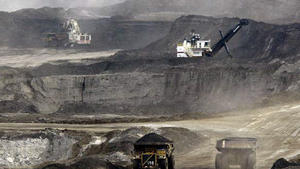EnergyEmissions from oil sands-derived fuels too varied for uniform low-carbon standards
Policy makers need to be cautious in setting new low-carbon standards for greenhouse gas emissions for oil sands-derived fuels as well as fuels from conventional crude oils; researchers found that lifecycle greenhouse gas (GHG) emissions vary widely across both actual surface mining and in situ oil sands operations and conventional crude cases reported in the scientific literature, depending on individual project operating conditions, technology used, and other factors

A Canadian open-pit oil sand mining operation // Source: canadameet.me
Policy makers need to be cautious in setting new low-carbon standards for greenhouse gas emissions for oil sands-derived fuels as well as fuels from conventional crude oils, University of Calgary and University of Toronto researchers say in a new study.
A research team, using for the first time confidential data from actual oil sands operations, did a “well-to-wheel” lifecycle analysis of greenhouse gas emissions from transportation fuels produced by Alberta oil sands operations compared with conventional crude oils.
A University of Calgary release reports that they found that lifecycle greenhouse gas (GHG) emissions vary widely across both actual surface mining and in situ oil sands operations and conventional crude cases reported in the scientific literature, depending on individual project operating conditions, technology used, and other factors.
Their study was published in the journal Environmental Science and Technology.
“Our study suggests it is not productive to get bogged down in a debate over whether fuels derived from the oil sands emit 5 percent or 20 per cent more GHG emissions than fuels produced from conventional oils,” says Joule Bergerson, who led the University of Calgary group for the study.
Heather MacLean led the University of Toronto group. “We need to focus instead on finding a transparent, consistent and reliable way of accounting for and reporting well-to-wheel greenhouse gas emissions across the industry and the entire economy,” says Bergerson, assistant professor of chemical and petroleum engineering in the Institute for Sustainable Energy, Environment and Economy and the Schulich School of Engineering.
“The key message is that there are large, and overlapping, ranges of potential well-to-wheel GHG emissions performance of both oil sands and conventional crudes. Therefore, ranges rather than point estimates should be utilized to represent this performance,” Bergerson says.
Policies such as low-carbon fuel standards and a focus on reducing oil sands operating emissions alone is an initial step, but will not be sufficient to achieve meaningful long-term environmental policy goals, the researchers said in the study.
— Read more in Joule A. Bergerson et al., “Life Cycle Greenhouse Gas Emissions of Current Oil Sands Technologies: Surface Mining and In Situ Applications,” Environmental Science and Technology (5 June 2012) (DOI: 10.1021/es300718h)
